
“Is man wrong to reach beyond his established boundaries?
The answer is, what is the motive?
If it is to extend the boundary of knowledge,
then it is right for him to explore wherever he can.
But if the motive is to gain an advantage which will
enable him to do harm to others with whom he shares his planet,
then there can be no justification for it.”
Miyoshi
This spiritual post is about someone so special that he is called “Prince among men, a man in a million”, who is revered in a way no one else is in today’s India. His influence in his days was so profound that those who met him were instantly captivated by his magnetic and complex personality, his vast knowledge of virtually anything and everything, his wisdom, his ability to speak on any subject without preparation and anywhere, and his legendary, unique memory. He was one of the greatest thinkers of all time, and to get the right perspective and to be able to write about him, I studied all 8 volumes of his work and was greatly impressed by his ideas, his thoughts, and his passionate beliefs.

THE WANDERING MONK
This sequel to the life story of Swami Vivekananda is devoted to his years as a wandering monk. It started when in July 1890, he left the monastery and lasted until he boarded a steamer SS Peninsular on 31st May 1893 to sail to America.
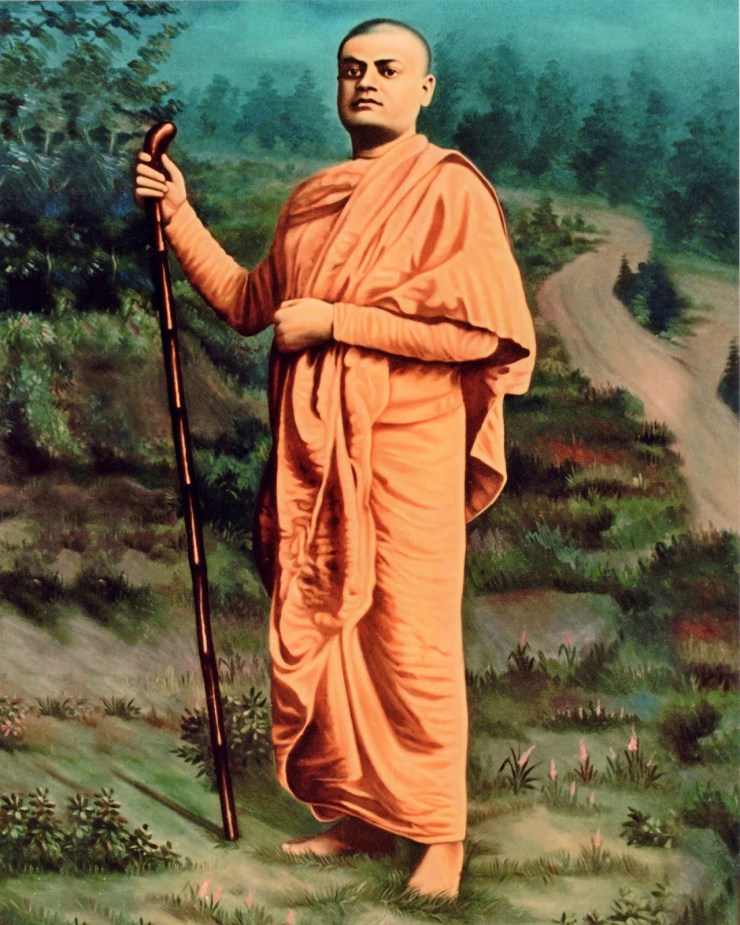
The very appearance of Narendranath in his saffron robe with a kamandalu or an ascetic’s water pot in one hand and the danda or staff in the other, his only other possessions being his two favourite books: the Bhagavad Gita and The Imitation of Christ, made him instantly noticeable wherever he went. He travelled mainly on foot. The first city he visited was Varanasi, the home of monks, the centre of learning, and the seat of Lord Shiva. Although I wrote about his stay at Varanasi in my last post, I am writing about it again as this is how his days as a wandering monk started. There, Swami met with many scholars and sanyasis and exchanged many ideas with them. He wanted to earn everything about the different religious practices. What made a lasting impression on Swamiji was the atmosphere of holiness, the sacred Ganges, the praying votaries, the temples of Viswanath and Annapurna, the knowledge that both Buddha and Shankaracharya had preached there. During his wandering, he developed a deeply felt desire to help the poor, often starving masses.
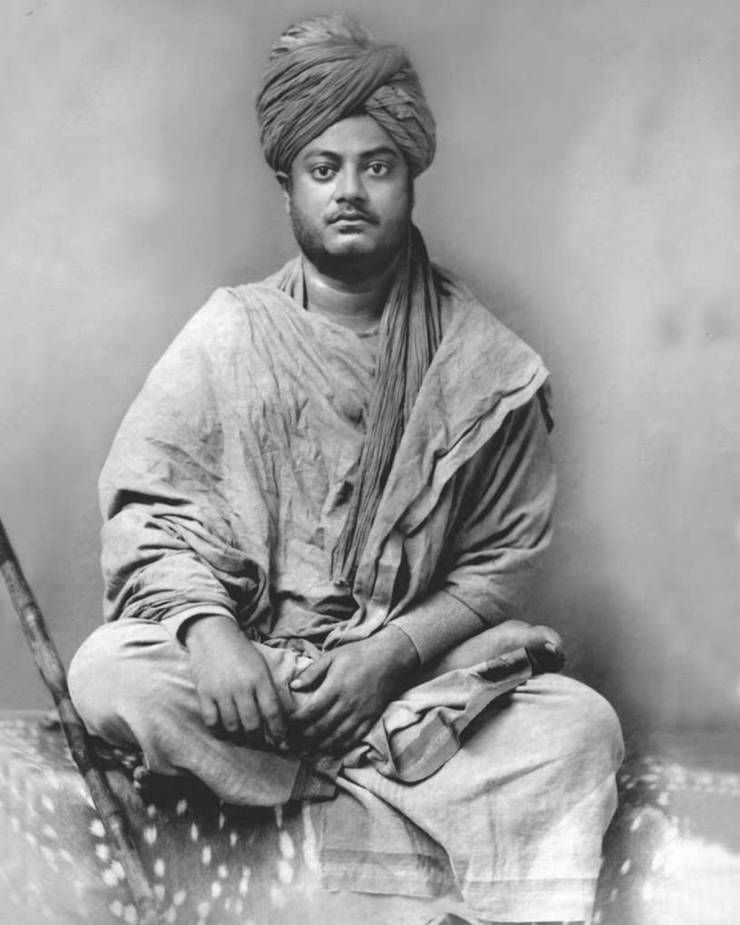
He also visited nearby Sarnath, where Buddha had preached his first sermons. During his stay, Swamiji had a unique experience that taught him a lesson, which years later, he recounted in a lecture in New York. It was a simple encounter with monkeys, who shrieked, howled, and chased him. He sought refuge in a temple but was advised by an old sanyasi, who was passing by, to confront them. When he accosted the monkeys, they fled. Swamiji referred to this incident as a lesson for life and advised people to “face any situation boldly, and then, like monkeys, the hardships of life fall back.”

Next, he visited Ayodhya, which was the birthplace of Lord Rama and also the kingdom where Ram had introduced Ram-rajya. An ancient town, Ayodhya is regarded as one of the seven sacred cities of the Hindus, revered because of its association in the great Indian epic poem Ramayana with the birth of Rama and with the rule of his father, Dasharatha. According to this source, the town was prosperous and well fortified and had a large population.
Ayodhya
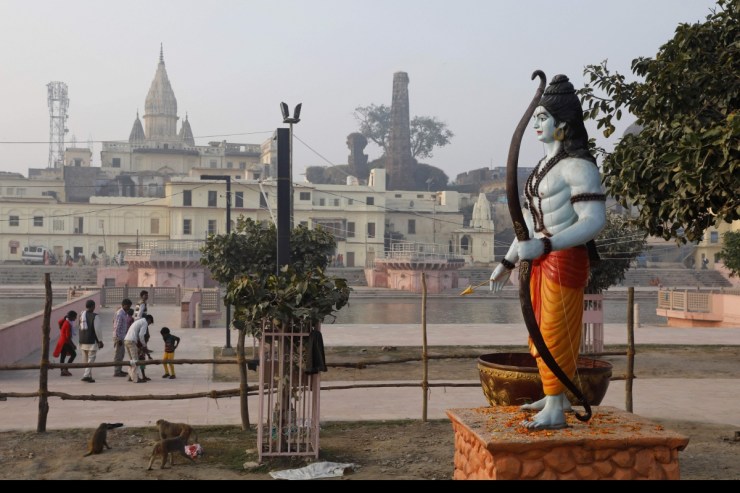
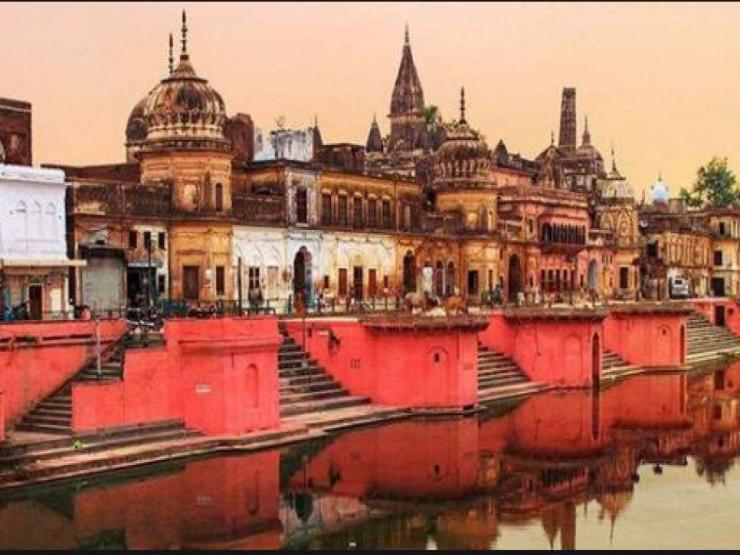
From Ayodhya, he went to Lucknow, where he was awestruck by the splendours erected by the Oudh dynasty. Lucknow became important in 1528, when it was captured by Babur, the first Mughal ruler of India. Under Akbar, his grandson, the city became part of Oudh province. Āṣaf al-Dawlah, who became Nawab of Oudh (now Ayodhya) in 1775, transferred his capital from Faizabad to Lucknow.
The Chota Imambara monument in Lucknow, the capital of Uttar Pradesh

Charbagh Railway Station in Lucknow

Swamiji’s next stop was Agra, where the Taj Mahal filled him with wonder and admiration. There was an early reference to an “Agravana” in the ancient Sanskrit epic Mahabharata, and Ptolemy is said to have called the site “Agra.” The city was founded by Sultan Sikandar of the Lodi dynasty in the early 16th century to be the capital of the Delhi sultanate. Agra also served as the Mughal capital during some periods of that empire.
The Taj Mahal was designated a UNESCO World Heritage Site in 1983. A complex mausoleum, the Taj Mahal is often considered to be the world’s best example of Mughal architecture. The Mughal emperor Shah Jahan built it for his favourite wife, Mumtaz Mahal, in the mid-17th century.
The Taj Mahal in Agra

The Agra Fort (16th century), shown below, is called the Red Fort for its massive red sandstone walls, and was built by the emperor Akbar; it contains the Pearl Mosque, constructed of white marble, and a palace, the Jahangiri Mahal. The fort was also designated a World Heritage site in 1983.

After Agra, it was Vrindavan, the erstwhile abode of Lord Krishna, and there, Swamiji was in ecstasy. The town is the sacred centre of the Hindu deity Krishna and those who worship him, and is a major pilgrimage site. It was in Vrindavan and its surrounding forests that the key events of Krishna’s mythological life took place.
The Sri Sri Krishna Balaram Mandir (Iskcon Hindu Temple) in Vrindavan


Swamiji planned to go to Haridwar from Vrindavan, and in that direction, he approached the Hathras railway station where he found his first disciple in Sarat Chandra Gupta, the assistant station master. Sarat Chandra was so enamoured by Swamjij’s personality and preaching, that he gave up his job, renounced the world, and joined Swamjij in his wandering. Accompanied by Sarat, Swamjij moved on to Hrishikesh.
Hrishikesh Temple

There, they both lived in the company of other sadhus and passed their time in spiritual discussions and disciplines. The closeness of the murmuring Ganges, the call of the Himalayas, beckoning him from the mountain tops made Swamjij elated.
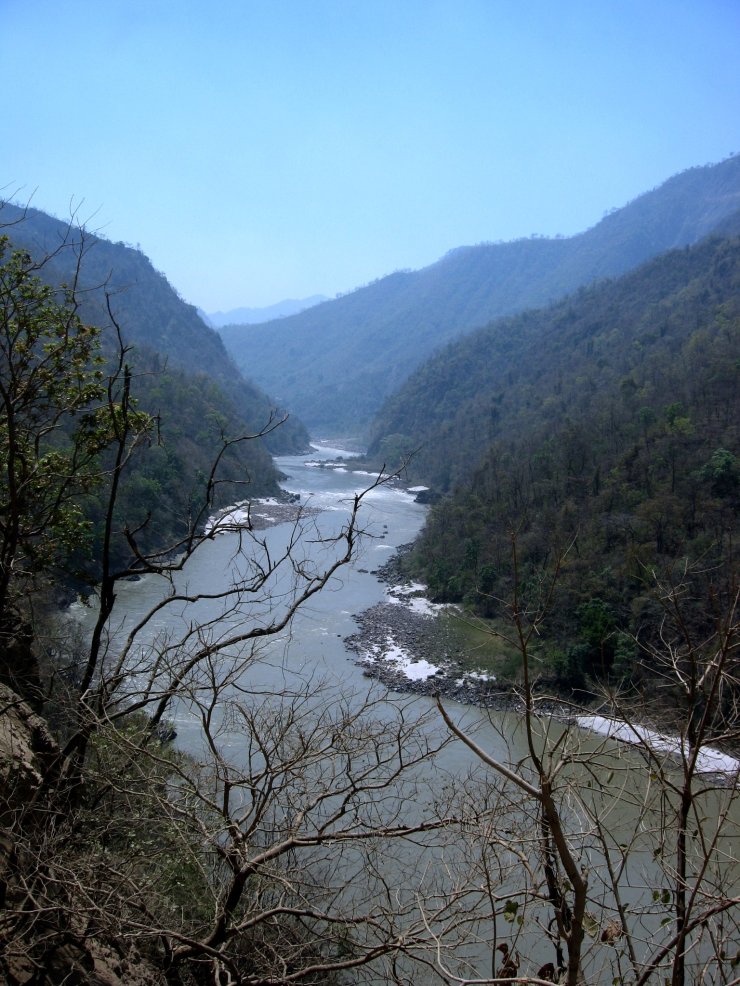
However, as the saying goes – tell God your plans, make Him laugh – first Sarat fell seriously ill, then Swamjij fell ill too. On the insistence of his disciple, Swamjij had to return to Calcutta (Kolkata) where he stayed for almost a year before he set out for another sojourn, first to Baidyanath Dham in Bihar.
Basukinath Temple, one of the most auspicious temples dedicated to Lord Shiva in Baidyanath Dham
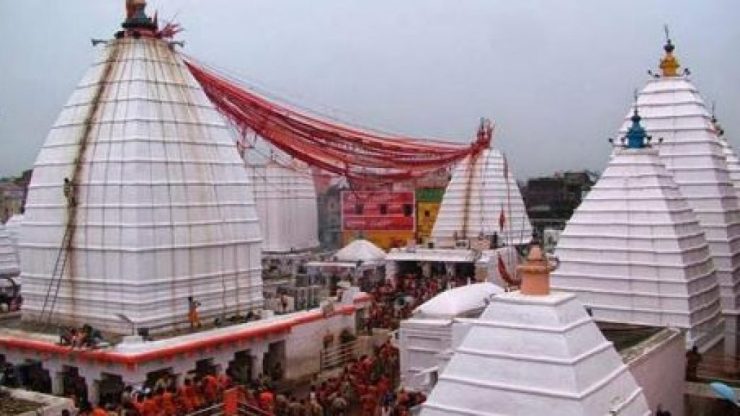
Naulakha Mandir, a 146-feet-high temple dedicated to the divine duo of Radha and Krishna, is located close to the main temple.

The news of the illness of another disciple at Allahabad (Prayagraj) made Swamiji change his itinerary from Varanasi to Allahabad, the city of the confluence of the Ganga, Yamuna and the mythological Saraswati.
Allahabad

Allahabad University

From Allahabad, Swamiji went to Ghazipur to meet Pawhari Baba, a master in the Advaita Vedanta system. It was at Ghazipur that he had the first opportunity to give his treatise on the Sanatana Dharma to some European officials who had come to meet him, and who, after listening to him, encouraged him to go to Europe to preach his ideas.
Pohari Baba Math in the ancient city of Ghazipur, a historical city full of traditional substance, established by Syed Masood who ruled until 1330. Earlier the city was known as Gadhipuri, though later it was changed to Ghazipur.
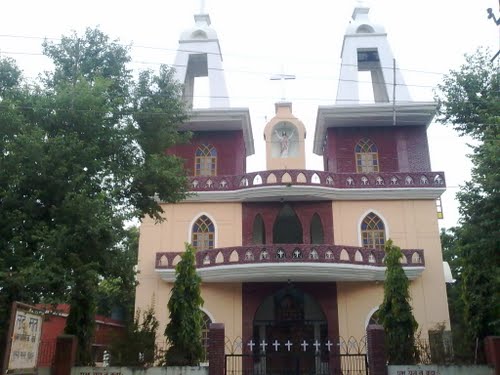
From Ghazipur, Swamiji went back to Varanasi, where the death of Balaram Bose – the great lay devotee of Master – on 13th April 1890, sent him back to Calcutta. With the death of Surendra Nath Mitra – another great lay devotee of the Master and a benefactor of the Math – on 25th May, the brotherhood experienced a financial crunch. Girish Ghosh and Mahendra Nath and some others did extend help heartily but it was not sufficient. The monks decided to lead a wandering life and thus reduce the expenses of the Math. This time Swamiji stayed in the monastery for about three months, and then set out again in the third week of July, with the same determination of not returning until the time he had achieved his spiritual goal. This time, at least in the initial phase, Gangadhar, whom Swamiji affectionately addressed as “Ganges,” accompanied him. Their first halt was Bhagalpur, where they put up at Manmatha Nath Chowdhury’s place. Manmatha Babu was a staunch Brahmo who was ‘re-Hinduised’ by Swamiji’s eloquence and spirituality.
Bhagalpur


Swamiji also interacted with the Jain monks at the temple of Nathanagar and found out the relationship between Jainism and Buddhism. The next stop was Baidyanath Dham, and from there they went to Ghazipur and after that to Ayodhya, where they met Mahant Janakibar Saran, a scholar of Sanskrit and Persian.
Phalgu River, Bihar
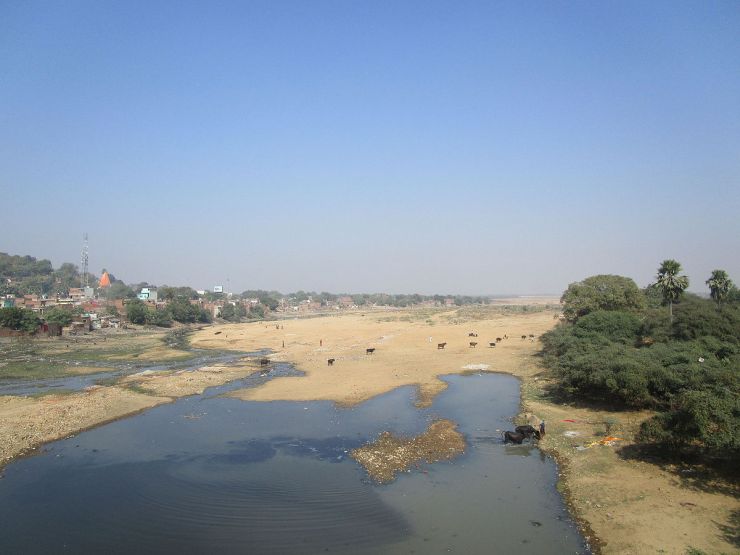
The next place on Swamiji’s itinerary was Nainital and from there they reached Almora en route to Badrikashram. One day, Swamiji was meditating under a peepal tree at a place called Kakrighat, situated about fourteen miles away from Almora at the confluence of the two rivers Koshi and Swial, when he experienced seeing “the whole universe within an atom.”
A Peepal Tree

It was also near Almora that Swamiji came across a solitary cave where he started performing the most severe forms of spiritual practice in search of the Truth. At Almora, Swamiji met other devotees of the Master and they left for Garhwal on the way to Badrinath Dham. However, the government closed the road to Badrinath, and Swamiji, and the others, after wandering in the Garhwal and Tehri, finally reached Dehradun about two months later.
Remnants of now submerged Tehri

The ancient Baori Shiva temple on the outskirts of Dehradun, was where Swami Vivekananda rested for three weeks in 1890, on his way to the Himalayas.
Shiv Mandir, another temple dedicated to Shiva, in Dehradun, shown below. It is popularly known as Prakasheshwar Mahadev Mandir among locals as well as devotees. Here you can see many pictures and idols of gods and goddesses . Every day the temple is decorated with flowers. Special poojas are held on the occasion of Shivratri & Sawaan.

Swamiji once again went to Hrishikesh, where he had an attack of diphtheria and was saved by a sadhu. The Devan of Tehri was passing by Hrishikesh at that time and on learning about Swamiji’s illness visited and referred him to an hakim or a Mohammedan doctor in Delhi. But Swamiji, feeling better, proceeded to Hardwar first, then to Saharanpur, and then to Meerut where he was reunited with a few of his disciples, and they set up a second Baranagar Math in the garden at the Sheth-ji’s garden. They passed the time meditating, praying, singing devotional songs, and studying the scriptures and other literature in Sanskrit and English.
Hastinapur, near Meerut

After some weeks Swamiji left his devoted brethren at Meerut and traveled alone to Delhi. It was the later half of 1891. The imperial bearings of the city, its long history as a capital of India, both under Hindu and Muslim dynasties, and the crisp winter air, all impressed the learned monk greatly.
The Red Fort in Delhi
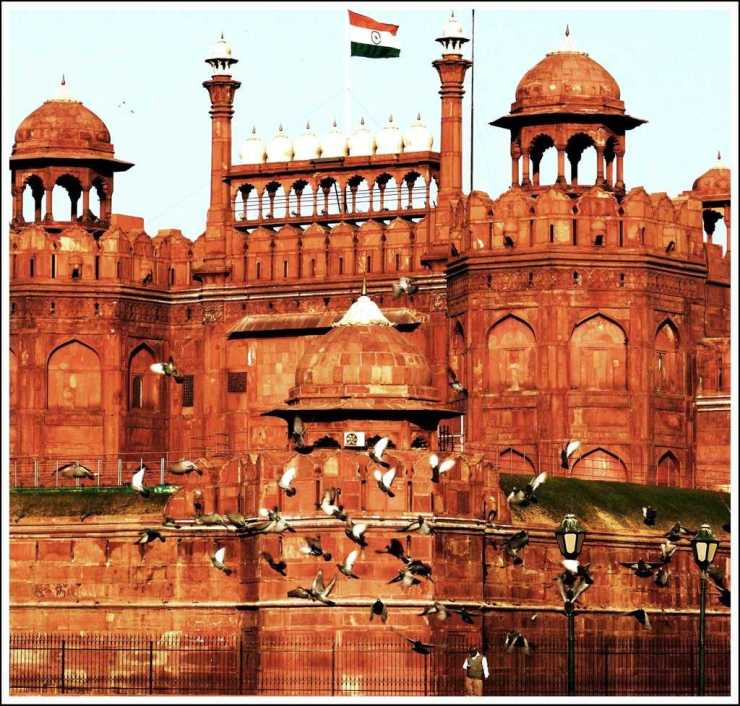
From Delhi, Swamiji set off for Rajasthan. His first stop was there was the erstwhile princely kingdom of Alwar. At the state dispensary, he met a doctor-in-charge, who was a Bengali. He guided Swamiji to a room at the local market where the Swamiji could put up and introduced him to a Muslim friend of his who was a teacher of Urdu and Persian at the local high school.
Neemrana Fort Palace in Alwar

An Indian Market

Soon, the news of Swamiji’s depth in religious matters spread, and the increasing daily gathering forced his host to move Swamiji to the house of Pandit Shambhunath, a retired engineer. Both Hindus and Muslims of various castes and sects, and belonging to different social strata came to him, and Swamiji treated them all alike. Many would then become his devotees and he would partake many of his meals at the houses of his Muslim followers too.
Maharaja Palace in Alwar
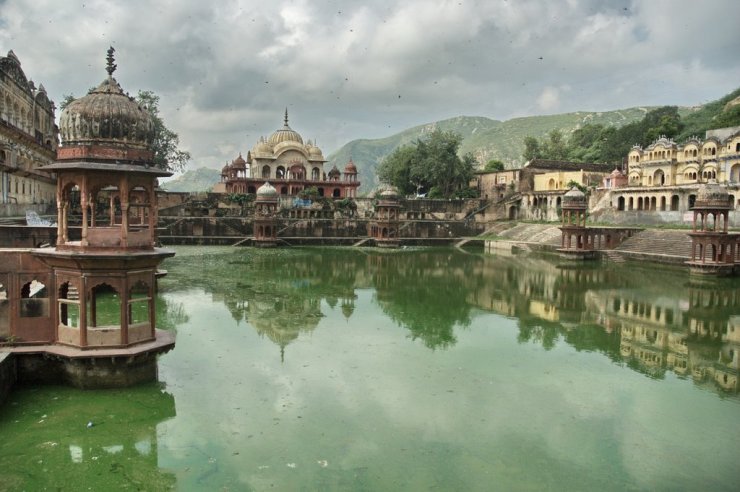
There, Swamiji met the Maharaja of Alwar, Mangal Singhji, and he was enamoured by Swamiji’s intelligence and knowledge. They held many discussions and Swamiji was always the winner.
City Palace in Jaipur


Next, Swamiji spent two weeks in the Kingdom of Jaipur, where he became friendly with Sardar Hari Singh, the Commander-in-Chief of the state, at whose place he spent some days discussing spiritual and scriptural matters.
Ajmer

From Jaipur, he moved on Ajmer, a city replete with memories of the magnificence of its Hindu and Muslim rulers, and the seat of the dargah of the Muslim saint Moinuddin Chisti, who is revered by both Muslim and Hindu alike.
Mount Abu

From Ajmer, Swamiji proceeded to Mount Abu; the town is a noted hill resort and the site of the famous Jain temples or the Dilwara Temples, built of marble, an architectural delight. Tejpal temple, built about 1200 CE, is known for the delicacy and richness of its carving, especially for that on the underside of its dome. The earlier Vimala Vahasi temple, built about 1031, is simpler and bolder in style. Guru Peak on Mount Abu (5,650 feet or 1,722 metres) is the highest point in the Aravalli Range.
Luna Vasahi Temple in the Dilwara temple complex
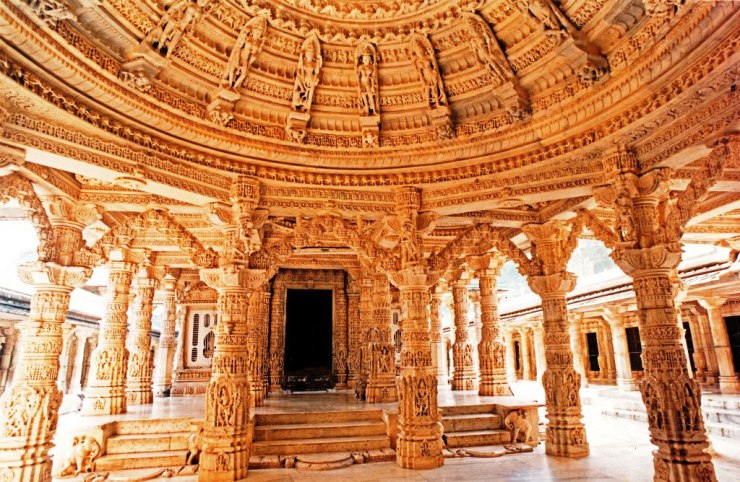
It was there that Swamiji met the Raja of Khetri, who became one of his greatest devotees. It was the Muslim man who first met Swamiji in a cave in the rocks of the mountain and was so influenced by Swamiji knowledge, that he begged him to come and stay at his bungalow. To this bungalow, during Swamiji’s stay, came Munshi Jagmohanlal, the private secretary to the Raja of Khetri. He asked how a Hindu monk could stay at a Muslim’s place. Swamiji replied, “Neither God nor the scriptures envisaged such division but it was the society that enforced such division to suit itself.” Jagmohan was dumbfounded at both Swamiji’s reply and the radiance emanating from him and invited Swamiji to meet his King.
Hawa Mahal Palace in Khetri

According to the state diary of the Khetri state, the first meeting of Raja Ajit Singh of Khetri with Swamiji took place in the presence of Hardayal Singh of Jodhpur on 4th June 1891. Over the next few days, the Raja broached various subjects to Swamiji, who also sang in his beautiful voice to entertain the royal guests. His words of wisdom influenced the Raja beyond imagination and he begged Swamiji to come to Khetri with him and give him the opportunity “to serve… with my whole heart.”

Swamiji left Mount Abu with the Raja of Khetri, and after travelling through Jaipur, Khairthal, and Kota, they reached Khetri on 7th August 1891. Satisfied with the spiritual inclination of the Raja, Swamiji gave him several lessons in spirituality. Swamiji was much moved by the depth and sincerity of the Raja, and he became one of the few privileged ones to receive Swamiji’s letters even from America.
Letters from Swamiji to the Raja

At Khetri, a chance encounter with a nautch (intricate Indian dancing) girl taught Swamiji a very valuable lesson. One night, the Raja had brought over a nautch girl to entertain his guests, Swamiji being one of them. But Swamiji declined to go and see her perform. This saddened the girl and she started singing a composition of the Vaishnav saint Surdas, a couplet that stressed the manifestation of the One in all beings. Swamiji realised that he could not discriminate against anyone. He immediately went to the hall where the guests had gathered.
A nautch dancer
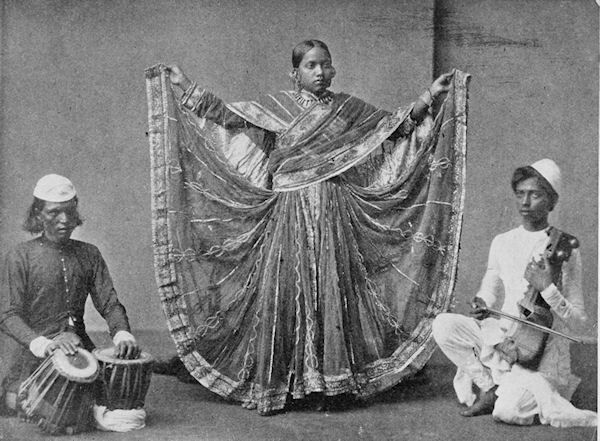
Swamiji was at Khetri for more than two-and-half months and left for Ajmer on 27th October 1891. After two weeks there he left for Bombay Presidency, now joined into provinces of Gujarat and Maharashtra. The first on his list was Ahmedabad, earlier known as Karnavati and one of the most handsome cities of India. The city was founded in 1411 by the Muslim ruler of Gujarat, Sultan Ahmad Shah, next to the older Hindu town of Asawal. Ahmadabad grew larger and wealthier for a century, but dynastic decay and anarchy eventually brought about a decline, and the city was captured in 1572 by the Mughal emperor Akbar. Its renewed eminence under the Mughals ceased with the death of Aurangzeb in 1707. Swamiji was fascinated by the splendour of the architecture and culture of the Sultans of Gujarat, under whose reign Ahmedabad had served as the capital.
Shree Swaminarayan Mandir Kalupur is the first Temple of the Swaminarayan Sampraday, a Hindu sect. It is located in Kalupur area of Ahmedabad, which is the largest city in Gujarat. It was built on the instructions of Swaminarayan, the founder of the sect.
Swaminarayan temple in Ahmedabad
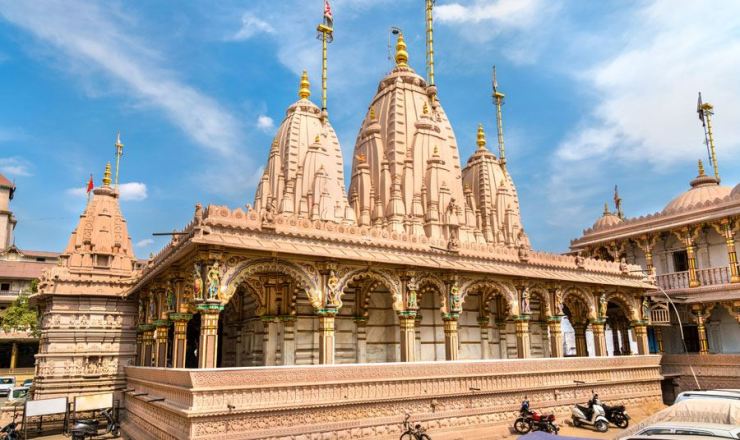
The Royal Mosque in Ahmedabad

The next stop was Limbdi where he went via Kathiawar. During local princely states existence in Kathiawar, there were approximately 222 small and medium princely states. During that era, Limbdi was also a princely state. During the time span from 1768 to 1948, many rulers had taken charge of Limbdi starting from Harisinhji, Bhojrajji, Harbhamji, Fatesinhji, Jashwantsinhji, Jatashankar. The prince of the state was greatly impressed by Swamiji’s preaching on Vedanta and gave Swamiji the idea of going to the West, he himself having visited England and America a few years earlier.
Shri Swaminarayan Mandir in Limbdi

After leaving Limbdi, Swamiji went to Junagadh via Bhavnagar and Sirohi. Thakore Sahib had given him a letter of introduction, and at Junagagh he was the guest of Haridas Viharidas Desai, the Diwan of the state. The Ashoka Stone – situated on the outskirts of the town – had the inscriptions of Emperor Ashoka and was of great interest to Swamiji. He also visited the nearby pilgrimage site Girnar, a conglomeration of ten hills, the highest of which is known as Gorakhnath. The Girnar is sacred to Buddhists, the Jains, and the Hindus alike, and ten thousand-odd steps, cut into the rocks, lead to many Jain and Hindu temples built on the different hills.
The Girnar


Temple of Gorakhnath

Swamiji’s next destination was the ancient city of Veraval and the great ruins of Patan Somnath, which have been destroyed and rebuild seven times. There are many myths and legends tagged to the temple. As per one, the ancient temple of Somnath is believed to have been built by Som – the Moon god himself. It is said that due to a curse the Moon lost its gleam. To break the curse, he took a holy dip at the site of Prabhas Patan, which is also a confluence of three holy rivers – Hiran, Kapila and the mythical river Saraswati, and prayed to Lord Shiva. Hence, Lord Shiva appeared here as ‘Somnath’ – Lord of the Moon, who freed him from the curse.
The Somnath Temple, Veraval


Swamiji also visited the new Somnath Temple built by Rani Ahalyabai of Indore. He bathed at the confluence of the mythological Saraswati, Hiranya, and Kapila rivers.
Sudama Temple, Porbandar

Soon after, Swamiji visited another ancient city of Sudamapuri, near Porbandar. Here, he was the guest of Pandit Shankar Pandurang, the Dewan and administrator of Porbandar, and a great Vedic scholar, who was at that time translating the Vedas. At the insistence of Pandit Pandurang, Swamiji stayed on for some days at Porbandar and helped him with the book. While at Porbandar, Swamijij read Panini’s Mahabhashya and learned French on Pandi’s insistence. Pandit told Swamiji to go to the West where “people will understand you and your worth.”
Hari Mandir, Porbandar

At around this time, Swamiji started thinking of travelling abroad to America and Europe. He was very much disturbed at the degradation of the glorious ancient culture of his country by the stupid activities and dichotomous lives of its so-called leaders who preached reforms but did not practise them, and blinded by the glare of foreign rulers were trying to suppress the age-old experiences of the native culture. He, therefore, felt that in order to enable the civilised world to have a truer picture of India, he must first reach out to them. He had become restless to bring about a spiritual regeneration in India.
Dwarka
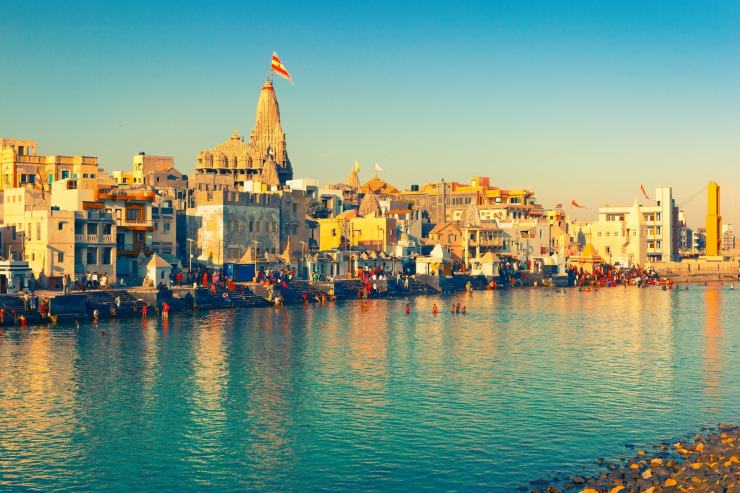
The next destination was Dwarka, a city resplendent with legends of Lord Krishna, to whom the stunning Dwarkadhish Temple is dedicated. It has been said that the temple is 5244 years old. It was built by Vajranabh, the great-grandson of Sri Krishna. This is where the Hari Griha or the home of the Hari or Krishna once stood, making this land holy. The five-storey structure of the Dwarkadhish Temple is built on seventy-two pillars. The temple spire is 78.3m high. From the temple dome, an eighty-four-foot long multicoloured flag decorated with the symbols of the sun and moon waves with beautiful colours of the rainbow. The Jagat Mandir has a tall tower and a hall of audience for mass announcements for devotees. There are only two entrances to the temple. The main entrance (north entrance) is known as “Moksha Dwara” (meaning Door to Salvation). The south entrance is known as “Swarga Dwara” (meaning Gate to Heaven). Outside this doorway, there are 56 steps that lead to the Gomati River.
The Tower (Shikhara) over the Garbha Griha is built in a style replicating a mountain peak. There are 7 stories clearly visible, sometimes attributed to Dwarka being one of the 7 ancient cities or Sapta-Puris of India. The seven cities being Ayodhya, Mathura, Maya, Kashi, Avantika, Kanchipuram and Dwarka. Each Story represents a Puri with the bottom one representing the Dwarka. Looking at all the stories in one frame is like watching the whole of India represented in the temple.
The Tower of Dwarkhadish Temple

In Dwarka, Swamiji put up at the Sarada Math, the monastery founded by the Shankaracharya. The ruins at Dwarka saddened him deeply.
Shatrunjaya Hill Temple, Palitana


His next stop was Mandvi in Kutch, from where he traveled to Palitana, where the holy mountain Shatrunjaya – sacred to Muslims and Jains alike – is situated. There are approximately 863 marble-carved temples on the hills spread mostly in nine clusters, some being vast temple complexes, while most small in size. The temples were built over a period of 900 years starting in the 11th century. Kumarpal Solanki, a great Jain patron, probably built the earliest temples. It is said that sculptors’ skills and capacity to carve with abrasive cords (not tools) the intricate designs was paid on the basis of the marble dust that they had collected every evening after their hard labour.
From Palitana, he moved to Nadiad, where he stayed at the ancestral house of the Diwan Haridas Viharidas Desai of Junagadh. There he spent most of his time in the Diwan’s library, where he was thrilled to see some excellent paintings by Raja Ravi Varma, regarded as the greatest Indian painter.
Self-portrait by Raja Ravi Varma

Saraswati by Rajah Ravi Varma

Radha in the Moonlight by Raja Ravi Varma

In Swami’s words, “If education is identical with information the libraries are the greatest Sages in the world, and encyclopedias are the Rishis.” I have to add here that Swamiji having a unique photographic memory, read half of the volumes of the Encyclopedia Britannica only once, and remembered every word in it.
Nawab Bahadur Khanji III with his State Officials, including Diwan Haridas Viharidas Desai

Diwan died after a brief illness on 17 June 1895 at Nadiad. The whole town mourned his death and newspaper articles in India and abroad lamented his death. The Amrit Bazar Patrika (Calcutta), dated 30 June 1895 remarked “In him, India has lost one of her best sons.” London (Editorial) September 1895 remarked “By the death of Mr Haridas Viharidas, India has suffered a great and lamentable loss. People of India had no more unselfish, simple-minded and enlightened champion.” Swami Vivekananda wrote in a letter dated 2 March 1896 from New York to Tatya Saheb, nephew of Haridasji “Your uncle was a great soul and his whole life was given to do good to his country. He was a strong noble friend and India has lost a good deal in losing him.”
Swamiji’s next stop was Baroda (now Vadodara), the capital of the Gaekwads, where he put up at the residence of the Minister of the State. The earliest record of the city is in a grant or charter of 812 CE that mentions it as Vadapadraka, a hamlet attached to the town of Ankottaka. In the 10th century, Vadapadraka displaced Ankottaka as the urban centre. It seems also to have been known as Chandanavati, named for Raja Chandan of the Dor Rajputs, who wrested it from the Jainas. The city underwent periodic renamings: Varavati, Vatpatraka, Baroda, and, in 1971, Vadodara.
The history of Vadodara falls into a Hindu period (until 1297); a period under the Muslim Delhi sultanate (1297–c. 1401); an independent Gujarat sultanate, during which the nucleus of the present city was built (c. 1401–c. 1573); a Mughal Empire period (c. 1573–1734); and a Maratha period, during which it became the capital of the powerful Gaekwad dynasty (1734–1947).
Swamiji came to know that the prince of Limbdi was at Mahabaleswar, where he stayed with Thakore Sahib for about two and half months.
Lakshmi Villa Palace, Baroda
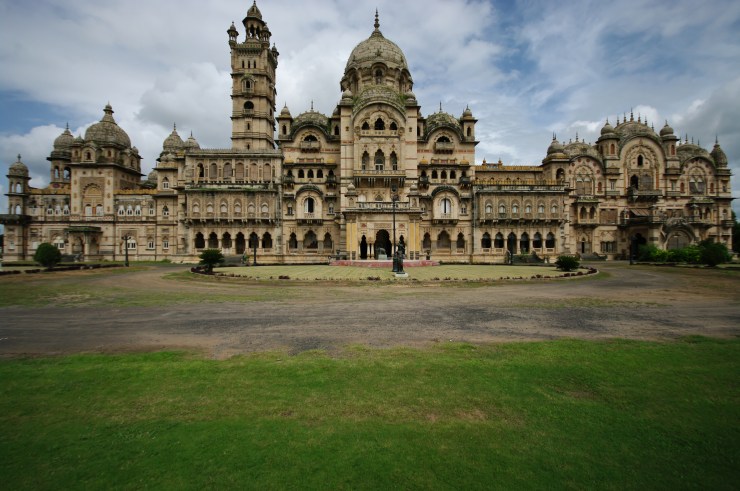
Swamiji then moved to Poon, having with him Thakore’s recommendation with him, and from there he went to Khandwa sometime towards the end of June 1892. Khandwa is identified with the Kognabanda of the Greek geographer Ptolemy and is traditionally said to have been surrounded by the Khandava forests that were described in the Sanskrit epic Mahabharata. In the 12th century CE, the city was an important seat of Jain worship.
Omkareshwar Temple, Khandwa

At Khandwa, Swamiji was a guest at the residence of Babu Haridas Chatterjee, a pleader in Khandwa of Bengali origin. Swamiji stayed there for about three weeks and then moved to Indore, and from there returned to Khandwa once again. This time he was acquainted with Akshay Kumar Ghosh, who was later adopted by an English lady. Miss Muller, and was subsequently instrumental in Swamiji’s visit to England from America in October 1894. It was at Khandwa that Swamiji first expressed his desire to attend the Parliament of World’s Religions at Chicago, of which he had first heard at Kathiawar.
Buddhist Cave at Kanheri
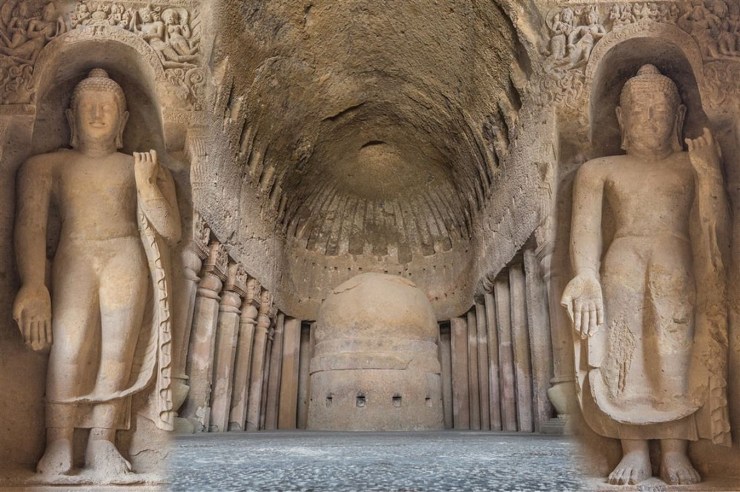
Swamiji left for Bombay sometime in July that year and was introduced to Seth Ramdas Chhabildas, a noted barrister in Bombay, who later travelled with him to Chicago. It was at Bombay that Swamiji came to know that the educated section of Bengal had opposed the Age of Consent Bill, and was very much pained to hear so. On the positive side, during his stay at Bombay, Swamiji visited the 109 Buddhist caves of Kanheri situated some twenty miles north of the city. This visit stirred him deeply as he felt that he lived here in a previous life.
Kanheri Caves

Swamiji stayed in Bombay for about two months and then left for Poona. As fate would have it, Lokmanya Bal Gangadhar Tilak was travelling at the same time and he was introduced to Swamiji. He stayed at Tilak’s place in Poona for about ten days, during which time he visited the Deccan Club with Tilak and gave an impromptu philosophical discourse which revealed to everyone present there his depth of knowledge on the subject. After this incident, people came to him in large numbers to know more about the Gita and the Upanishads.
Lokmanya Bal Gangadhar Tilak, visionary leader
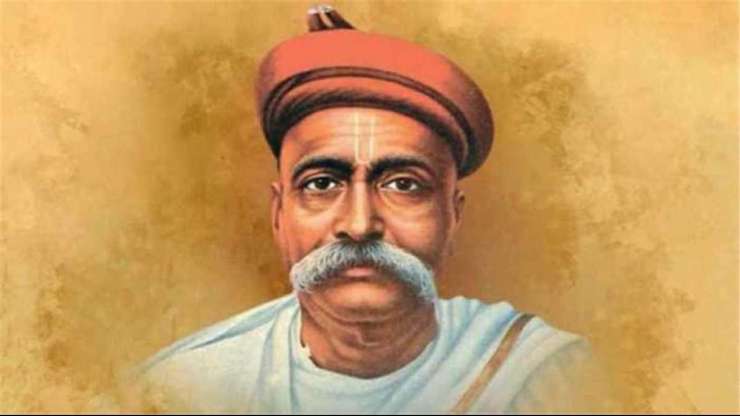
The next, Swamiji moved to Kolhapur. He gave the local Maharaja the introductory letter that had been given to him by the Maharaja of Bhavnagar. The Maharani of Kolhapur became a devotee of Swamiji and was able to persuade him to accept a new ochre cloth. After a short stay there, Swamiji moved southwards and reached Belgaum around 15th October 1892. The city dates from the 12th century. It later exercised strategic control over the plateau routes to Goa and the Arabian Sea coast to the southwest. Its early name, Venugrama, is said to have been derived from the bamboos characteristic of the region. A melting pot for the Kannada, Konkani, Marathi, and Goan cultures, modern Belgaum includes the original cantonment, the site of an oval stone fortress with a 16th-century mosque and of two Jaina temples, and the suburbs of Shahpur and Madhavpur.
Gokak Falls, Belgaum
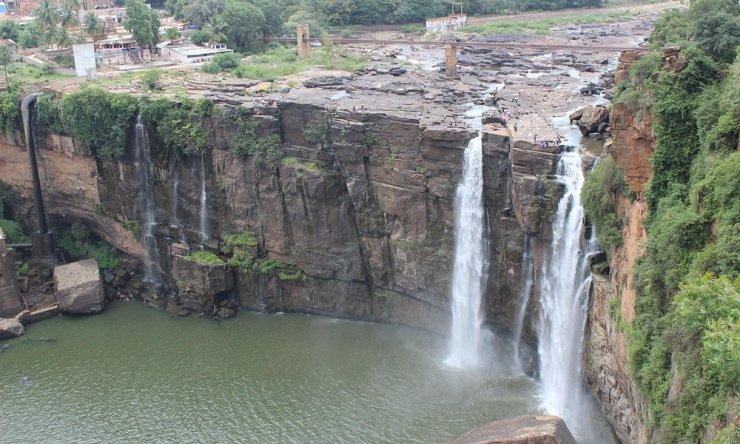
At Belgaum, Swamiji was the guest of a Maharashtrian gentleman who knew the private secretary of the Maharaja of Kolhapur. From the records of Prof. G.S. Bhate – the son of his host at Belgaum – it is found that the non-conforming flesh-eating Hindu monk, who had a deep grounding in Sanskript scriptures, initially upset his hosts. However, they soon discovered his extraordinary personality which as usual endeared him to the local gentility.
Beautiful Goa

From Belgaum, Swamiji reached Goa, which was then a Portuguese colony. Goa, now a state of India, comprises a mainland district on the country’s southwestern coast and an offshore island. It is located about 250 miles (400 km) south of Mumbai (Bombay). One of India’s smallest states, it is bounded by the states of Maharashtra on the north and Karnataka on the east and south and by the Arabian Sea on the west. The capital is Panaji (Panjim), on the north-central coast of the mainland district. Formerly a Portuguese possession, it became a part of India in 1962 and attained statehood in 1987.
A typical Portuguese villa in Goa

In Goa, Swamiji adopted the name Sachchidanand. The news of his arrival at Margao preceded him, and he was taken in a procession to the house of his host Subrai Naik, a learned gentleman, and friend of Dr. V.V. Shirgaonkar of Belgaum. The main object of Swamiji’s visit to Goa was to study Christian theology from old Latin texts and manuscripts which in India were available in Goa alone. Subrai Naik introduced Swamiji to a learned Christian friend of his, J.P. Alvares, who made immediate arrangements for Swamiji’s stay at the Rachol Seminary.
Rachol Seminary, Goa

Here rare religious literature in Latin, both in the form of manuscripts and print, were kept. Swamiji stayed at the Seminary for three days, and his diligence and grasp of the subject gained him friends from the Church as well. Subrai Naik became an ardent follower of Swamiji, and later on even sanyas, and became Swami Subramanayanand Tirtha. The room in Subrai Naik’s house, where Swamiji stayed, is still preserved in Vivekananda’s memory by Naik’s descendants, shown below.

Vidhana Soudha, a Government Office in Bangalore
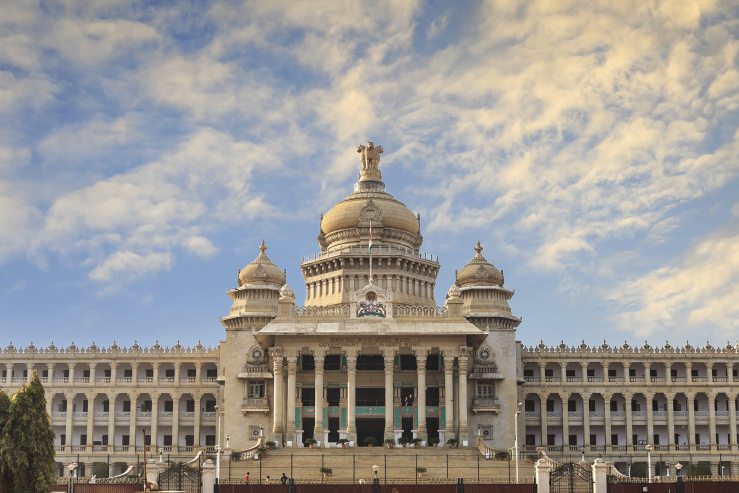
Swamiji left Margao by train for Bangalore via Dharwar.
Mysore Palace

At Mysore, Swamiji was residing at the Maharaja Shri Chamarajendra Wadiyar’s palace, in his own apartment. The Maharaja was greatly impressed by ‘such a brilliancy of thought, such a charm of personality, such wide learning, and such penetrating religious insight.’ In Mysore, he impressed Muslims with his knowledge of the Koran, others at the palace with his knowledge of Western music, and even an engineer installing the electricity at the palace with his knowledge of electricity. The Maharaja became greatly attached to Swamiji and promised to sponsor his visit to the West after hearing about the mission.
Maharaja Shri Chamarajendra Wadiyar

Swamiji left for Shornur, the gateway to Trichur. From there Swamiji moved to the state of Kodungalloor, famous for its Kali temple, and also a seat of Sanskrit learning.
Pooram Festival in Trichur

From there Swamiji went to Ernakulam, the capital of Kochi State. Ernakulam has played a part in the political history of south India since ancient times. The Jewish, Syrians, Arab, Chinese, Dutch, British, and Portuguese seafarers followed the sea route to the Kingdom of Cochin and left their impressions on the town. In 1896, the Maharaja of Cochin initiated local administration by forming a town council in Ernakulam. Initially, the district’s headquarters were located in the portion of the city known as Ernakulam, which gave the district its name; the headquarters was relocated afterwards to Kakkanad.
Old Ernakulam
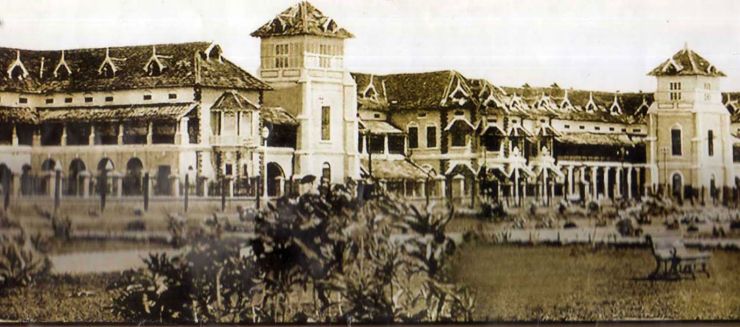
Swamiji left for Thiruvananthapuram around 6th December 1892, which was the capital of the state of Travancore.
Kalidas
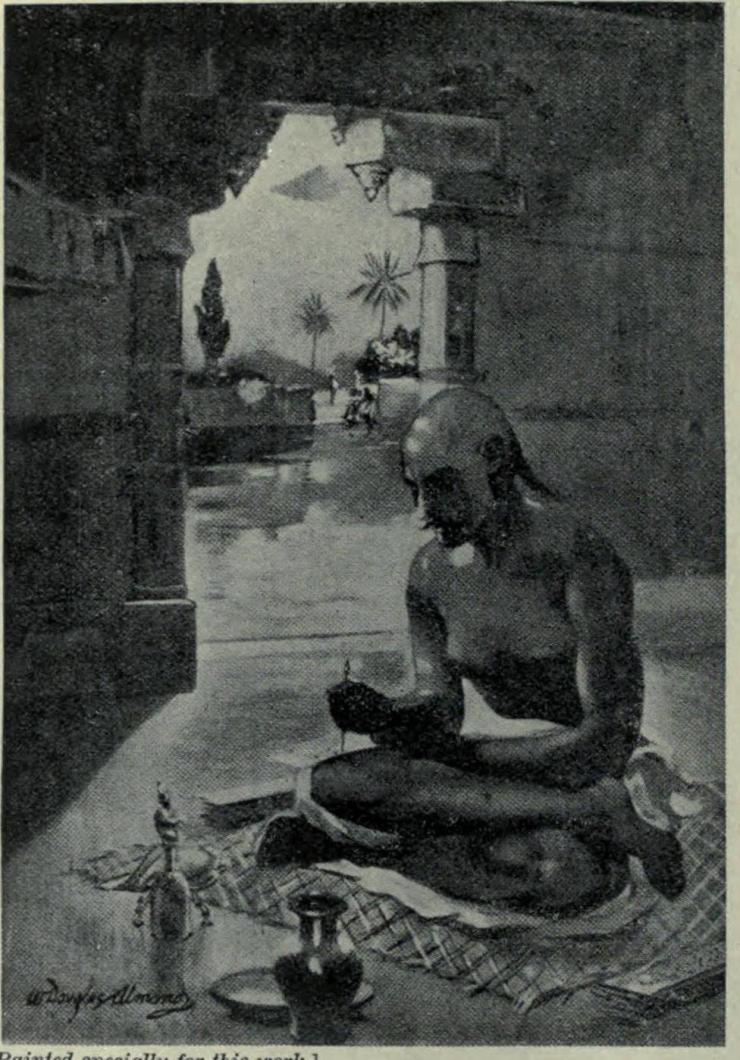
While there he held discussions with various scholars and would traverse from Spencer to Shakespeare and Kalidas, from Darwin’s Theory of Evolution to Jewish History, from Aryan civilisation to the Vedas, and from Islam to Christianity. He would say that of all living beings, “man alone has a hunger in his heart to know the whence and whither, the whys and wherefores of things.”
Vivekananda Rock Memorial

En route to Rameswaram, on 22nd December 1892, Swamiji reached Kanyakumari where he meditated on the rocks, now known as the Vivekananda Rocks. Swamiji wanted to meditate on the holy rock but there was no boatman and so, he plunged into the sea and swam across. His meditation lasted three days, during which he had a vision of the greatness and weaknesses that characterised his India. He recognised that it was not religion that brought about the downfall of India, but rather the diversions in the practice thereof, and realised that his country “shall rise only through a renewal and restoration of that highest spiritual consciousness that has made her the cradle of the nations, and the cradle of Faith.” That is, through the reinstatement of the culture of the rishis, the dominance of the priestly classes, the despotic caste system, and the divisions that it created in the social body making the majority of its followers outcasts, were insurmountable barriers to the progress of the Indian nation. He wanted to help the downtrodden masses and thought that he could earn money in America by the power of his brain.
Rameswaram Temple
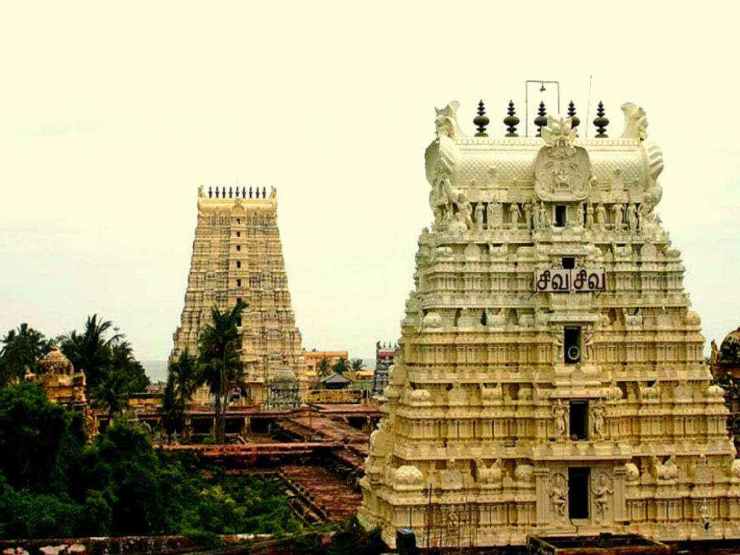
He left Kanyakumari to go to Rameswaram, which is immortalised in Ramayana as the place from where Hanuman and his monkey bridged the strait between India and Lanka, now Sri Lanka where Ravana held Sita captive. Recent NASA specialised photographs do indicate the existence of such a bridge. It is said that after winning the war with Ravana and rescuing Sita from Sri Lanka, Sri Rama set up a Shiva-lingam at Rameswaram. Swamiji Vivekananda had all along cherished a desire to pay his obeisance to Lord Shiva at this temple. Thus reaching Rameswaram was the culmination of his pilgrimage through India.

The life of a parivrajaka or wandering monk unfolded not only the character of the places that he visited but also a multitude of characters that would have otherwise remained uninitiated. Like the sweetmeat shop owner, who had a dream in which Ram directed him to take food to hungry Swamiji at Tari Ghat station, and was indeed the manifestation of a holy soul. Or the low caste poor man, who observed Swamiji talking continuously to the never-ending stream of visitors for three consecutive days without food or drink, and then very shakily agreed to cook food for Swamiji after a lot of persuasions, could not have been a lesser devotee of Swamijithan than his sovereign, the Maharaja of Khetri. His own realisation of the soul being the centre of power was as much illumination from within, as the eternity of the soul, “no fear nor death, never was I born, never did I die.” His soul glowed with the love for humanity and through his teachings, contained in 8 volumes, he will live forever.

The Publisher of this book, Swami Tattwavidananda, at Advaita Ashrama, Mayavati, Champawat, Uttarakhand, Himalayas, wrote:
“The whole world will remain ever indebted to Goodwin for his great role in handing down for posterity the immortal words of the great Swami.”
and in the words of the man himself, Swami Vivekananda:
“The debt of gratitude I owe him can never be repaid and those who think they have been helped by any thought of mine, ought to know that almost every word of it was published through the untiring and most unselfish exertion of Mr. Goodwin. In him, I have lost a friend true as still, a disciple of never-failing devotion, a worker who knew not what tiring was and the world is less rich by one of those few who are born, as it were, to live for others.”
Many thanks to the publisher, Advaita Ashrama, Mayavati, Champawat, Uttarakhand, Himalayas, for publishing the newest beautiful edition of The Complete Works of Swami Vivekananda.

I have completed so far over 10,000 words of two treatises on Swami Vivekananda’s life; it has to be a triptych as I haven’t shown the many interesting events of his tour of America and Europe. I will also write about the relationship between Nikola Tesla and Swami Vivekananda as readers have requested. See you next week.
🙏🌹🙏
LikeLike
I read this post again today, and it took about the same amount of time. If you love something, you don’t mind investing more time. I will not repeat what I have already said, but I would like to mention here that I was greatly attracted by the Ramakrishna Mission. During my stay in Delhi, I was a regular visitor to the Mission and a member of its library. Whenever I go to Kolkata, I make it a point to visit Ramakrishna Mission and Dakshineswar Kali Temple.
This post covers almost all the places in India from north to south and east to west, and reminds me of my association with most of them. At one place you have mentioned the Chhota Imambara of Lucknow, a place where I lived for 4 years. It also houses the Bara Imambara, which is known for its incredible Bhool Bhulaiya (Maze).
You have also mentioned that Swami ji saw excellent paintings of Raja Ravi Varma in Diwan’s library at Nadiad. Raja Ravi Varma had connections with royal family of Travancore. I had visited Raja Ravi Varma Paintings Art Gallery at Thiruvananthapuram, where I saw his various paintings.
I can go on and on, but people love reading you because you write as an insider, straight from the heart, as an Indian. Thank you, Joanna, for your mission to highlight the words and deeds of the a great soul like Swami Vivekananda.
LikeLike
Thank you, Kaushal, for your amazing comments that made my day!
You know that I love Swamiji and I am his devotee, this is why I write from my heart about his extraordinary teaching. I don’t know how but I have a spiritual connection with this great man and almost hear his voice asking me to write about his wisdom, and I more than happily oblige. More interesting details to follow.
I love, Kaushal, your comments because you add so much to my knowledge and every word matters to me. Thank you.
Joanna
LikeLiked by 1 person
It’s always my pleasure, Joanna! You’re welcome!
LikeLike
Thank you again!!
Joanna
LikeLiked by 1 person
This is clearly a labour of love, Joanna! A great story, beautifully told.
LikeLike
Thank you, Harini, for your words of wisdom and kind comment!
Yes, indeed, I love Swamiji and empathise with his teachings. There is no other writer who would inspire me to write 12.000 thousand words posts as he did. Two more interesting posts will follow, I think you will like it.
Thank you again!
Joanna
LikeLiked by 1 person
WOW Joanna, thank you so much for introducing us to the extensive journey of Swami Vivekananda’s devotion as a wandering monk. I don’t know if anyone would or could be as committed as he was in this day and time. Great research my friend. Great job on this article! 🤗🙏🏼😊💖✨
LikeLike
Thank you, Kym, for your kind comments! Swamiji was an extraordinary man, and I am devoted to writing about his life and his teaching. Two more interesting posts to follow.
Joanna
LikeLiked by 1 person
You’re doing a wonderful and very thorough job with your research Joanna. I applaud your dedication! He was indeed an extraordinary man! 😊💖🙏🏼
LikeLike
Thank you so much, Kym!
Joanna x
LikeLiked by 1 person
My dear Joanna, you are so very welcome my dear. 😍🙏🏼🥰
LikeLike
Fascinating buildings and beautiful photos 💕
LikeLike
Thank you, Morag, much appreciated.
Joanna
LikeLiked by 1 person
🤗🌷
LikeLike
Your labor of love is truly evidence of a strong devotion to Swamiji. Excellent job.
LikeLike
Thank you, Pat, for your wonderful comments! And yes, I am devoted to
Swamiji because as Neil, a drummer in Bruce Springsteen’s band wrote in his comment:
“He was an absolutely incredible person. One in a billion. Humanity is
lucky whenever people such as he are in our midst.”
That was after part 3, and part 4 is coming this week. I have never felt compelled to write over 12.000 words posts about anyone, and the reason is in Neil’s reflection.
Thank you again, Pat, your words and time are greatly appreciated.
Joanna
LikeLike